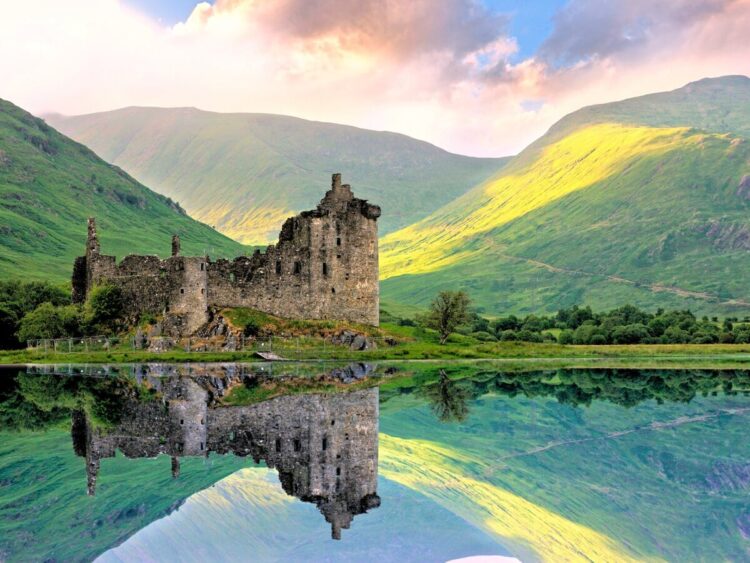[ad_1]
What Happened to Kilchurn Castle?
Nestled at the northeastern end of Loch Awe in Argyll and Bute, Scotland, lies the captivating ruins of Kilchurn Castle.
This once-mighty stronghold has witnessed centuries of Scottish history, from the rise of the powerful Campbells of Glenorchy to its eventual abandonment.
As you gaze upon its weathered stones, you can almost hear the whispers of the past, beckoning you to uncover the secrets of this enchanting place.

The Birth of a Stronghold
In the mid-15th century, Sir Colin Campbell, 1st Lord of Glenorchy, laid the foundation for what would become a symbol of his family’s power and influence.
Granted the lands of Glenorchy by his father, Duncan Campbell, Colin set out to establish a base that would ensure his loyalty and cement his position within the Clan Campbell.
The original castle comprised a five-storey tower house, with a courtyard defended by an outer wall.
Imagine the sense of awe and wonder that must have filled the hearts of those who first laid eyes upon this impressive structure, rising from the small island on which it was built.
Expansion and Growth


As the Campbells of Glenorchy grew in power and influence, so too did Kilchurn Castle.
Sir Duncan Campbell, Colin’s son, added the laich hall, a single-storey dining hall, to the south curtain.
The castle bore witness to the tragic loss of Sir Duncan, who fell at the Battle of Flodden in 1513, a somber reminder of the sacrifices made by the Campbells in service to their country.
In the latter half of the 16th century, Sir Colin Campbell, the 6th Laird, further enhanced the castle’s grandeur.
He added chambers to the north of the tower house and remodeled the parapet, introducing the iconic circular corner turrets adorned with corbels.
These additions not only improved the castle’s accommodation but also served as a testament to the Campbells’ growing prosperity and ambition.
The Rise of Black Duncan
Sir Duncan Campbell, 1st Baronet, known as “Black Duncan,” left an indelible mark on Kilchurn Castle.
This ambitious and powerful figure rebuilt and enlarged the south range in 1614, and constructed a new range incorporating a chapel in the south-east part of the courtyard.
Black Duncan’s improvements to the castle and the surrounding farmlands at Finlarig, Kilchurn, and Balloch Castles showcased his vision and determination to solidify the Campbells’ dominance in the region.
A Jacobite Stronghold
As the tides of history shifted, Kilchurn Castle found itself at the center of political turmoil.


In 1693, Sir John Campbell, 5th Baronet and newly created Earl of Breadalbane and Holland, transformed the castle into a modern barracks capable of housing 200 troops.
This move was part of a scheme to pacify the Highlands, but Breadalbane’s loyalties were complex. He negotiated with Jacobite rebels while serving William III, and even joined the Earl of Mar’s Jacobite rising in 1715.
The castle’s walls echoed with the footsteps of government soldiers during the Jacobite risings of 1715 and 1745, a reminder of the tumultuous times that shaped Scotland’s history.
The Decline and Abandonment
As the Campbells moved to the reconstructed Taymouth Castle in 1740, Kilchurn’s fate was sealed.
A devastating lightning strike in 1760 left the castle badly damaged, and by 1770, it lay in ruins, its once-proud walls crumbling under the weight of time and neglect.
Yet, even in its ruined state, Kilchurn Castle continued to inspire.
The renowned artist J. M. W. Turner immortalized the castle in his paintings during his tours of Scotland in the early 19th century, capturing the haunting beauty of this ancient stronghold.
The Castle Today
In the present day, Kilchurn Castle stands as a captivating ruin, a shadow of its former glory, yet still a magnet for those drawn to its rich history and stunning location.


The castle is now in the care of Historic Environment Scotland, who have opened it to the public during the summer months.
Visitors can reach the castle either by boat from Lochawe pier or on foot from the A85 near Dalmally. The journey itself is an adventure, as you make your way under the railway viaduct that crosses Loch Awe.
Be mindful, though, that the castle can sometimes become a temporary island when the water levels in the loch rise, adding an extra layer of intrigue to your visit.
As you approach the castle, you’ll be greeted by the sight of the once-mighty tower house, its walls still standing tall despite the passage of time.
The courtyard, where the Campbells once gathered and planned their next moves, now lies open to the sky, a silent witness to the centuries of history that have unfolded within its walls.
While the castle’s interior is currently closed due to conservation works, visitors can still walk around the exterior and drink in the breathtaking views of Loch Awe and the surrounding hills.
The signage on the security fencing speaks of the ongoing efforts to preserve this precious piece of Scottish heritage, ensuring that future generations can continue to marvel at its beauty and learn from its stories.


As you explore the castle grounds, take a moment to reflect on the lives of those who once called Kilchurn home. From the ambitious Campbells of Glenorchy to the soldiers who manned its walls during the Jacobite risings, each has left their mark on this incredible place.
And while the castle may be a ruin, its spirit remains unbroken. It stands as a testament to the enduring power of history, a reminder of the stories that have shaped Scotland, and an invitation to all who visit to become a part of its ongoing tale.
So, as you leave Kilchurn Castle behind, carry with you the memories of your visit, the awe-inspiring beauty of its setting, and the knowledge that you, too, have now become a part of its enduring legacy.
How do you feel about this article?
[ad_2]
Source link



No Comments
Leave Comment